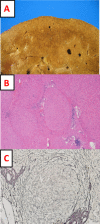The pathological differential diagnosis of portal hypertension
- PMID: 30992761
- PMCID: PMC6467111
- DOI: 10.1002/cld.655
The pathological differential diagnosis of portal hypertension
Figures








References
Publication types
LinkOut - more resources
Full Text Sources

